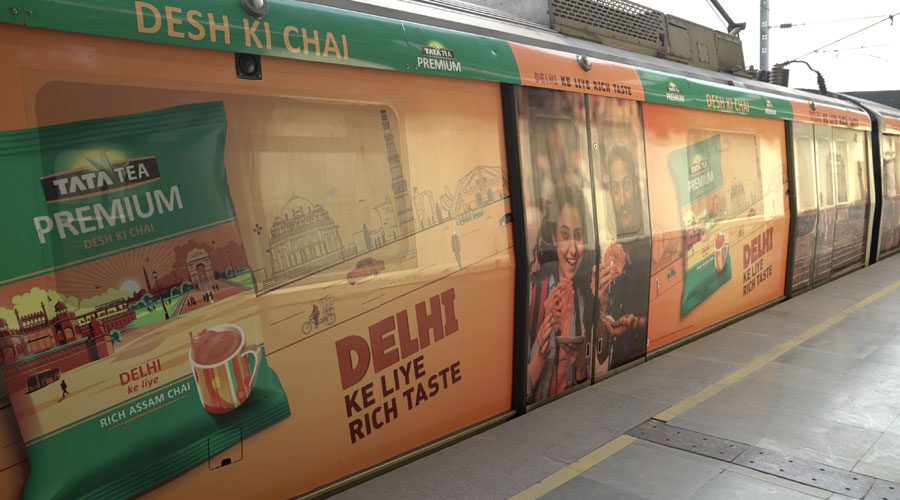
Recently, a metro train wrapped in the hues of Tata Tea Premium ran across the national capital, taking people places. While the outdoor visuals showcased the rich heritage of Delhi, feel-good stories about the region were splashed on the walls of the interiors. The brand’s idea was to harness the positive behind the stereotypes attached to Delhi and celebrate the pride felt by Delhiites. Puneet Das tells us more about Tata Tea Premium’s hyperlocal approach for this campaign.

Give us a bird’s eye view of the campaign
This campaign is part of our strategy on Tata Tea Premium restage to go hyperlocal and shift the needle from celebrating ‘India Pride’ to also evoking ‘Regional Pride’. For each state, we’ve introduced a marketing mix designed specifically for the state — whether it’s packaging, communication or the choice of communication medium. We have developed a state-wise communication based on local/regional-level insight and used hyperlocal media choices to effectively target the region. With the restage, we endeavour to disrupt the category by leveraging national stature while emphasizing our regional expertise.
View this post on Instagram
? ANNOUNCEMENT! Watch out for the Delhi Metro coaches on the yellow line to spot DIYA’s Harsh Kohli. ⠀ ⠀ Diabetes India Youth in Action in collaboration with @tatateapremiumofficial and @official_humansofdelhi shared a #DilSeRichDilli story of Harsh, who was diagnosed with #Type1Diabetes as a kid and his son was also diagnosed with the same.⠀ ⠀ His and DIYA’s story is out in the @officialdmrc coaches on the yellow line as a part of @tatateapremiumofficial ‘s campaign. ???⠀ ⠀ We, at DIYA, through various campaigns, aim to make the public aware about this chronic condition. There is an urgent need to educate people about Type1 diabetes, as in most cases, it goes undiagnosed. In spite of the large number of people with Type-1 diabetes in India, India is not a diabetes-friendly society. The society suffers from lots of myths regarding diabetes and insulin use. ??⠀ ⠀ According to the International Diabetes Federation (IDF) 2015 report, India comes second among the top three countries in world with people living with T1D. It is estimated that India is housing approximately 97,700 children with T1D. The ultimate aim is to help Type-1 diabetics in India live longer, more meaningful lives. ⠀ ⠀ If/When you spot this story on the yellow line of the Delhi metro, click a picture and do share it with us by tagging our social media pages! ?⠀ ⠀ #DAwareness #DiabeticLiving #DIYA #DiabetesIndiaYouthInAction #Insulin #Pancreas
A post shared by DIYA (@diabetes_india_youth_in_action) on Dec 31, 2019 at 1:10am PST
What was the original brief for the #DilSeRichDilli video?
The communication approach overall for the campaign is that most states are associated with certain stereotypes and perceptions which are generally an outsider’s perspective about that region. However, in our communication, we’ve tried to showcase an insider’s perspective that celebrates the positive truth behind these stereotypes, evoking pride among the viewers of the region. Delhiites are known for their flamboyant nature and are associated with everything that is over the top and ‘Rich’. However, Tata Tea Premium celebrates the true richness of Delhiites, which is their Dil Se Rich nature that gets manifested in everything they do.
Why was Delhi chosen by the brand for a hyperlocal campaign? Are there new products in the pipeline?
Tata Tea Premium has been a popular brand in Delhi and has always connected with the Delhiites at an emotive level. Hence, Delhi is one of the key markets for Tata Tea Premium. Apart from Delhi, we’ve also launched an Uttar Pradesh specific local campaign.
There is a stark difference in the social media footprint of the campaigns run for Delhi and UP. Could you talk about the different strategies at play here?
To effectively speak to the consumers of the region, we evaluated their local media habits and hence chose vehicles that effectively target the region. For instance, digital emerged as the lead medium in Delhi, whereas TV and Print were the lead mediums in Uttar Pradesh.
What is the expected RoI for this campaign?
The idea is to reinforce brand love by connecting with Delhiites at an emotive level by celebrating their pride for the region.
How can a brand leverage influencer marketing and story curation? Share lessons from your experience of #DilSeRichDilli.
Influencer marketing is a fast-paced marketing tool that is gaining more relevance and popularity among brands. The key factor is to identify the right set of influencers and not go for the ‘one size for all’ approach.
For our Delhi campaign, we associated with the young, new age Delhiites who are proud of their city — be its food, culture and monuments — and take pride in showcasing and talking about this in their social circle.
Also Read: ColorPlus Bengaluru stores put up mannequin cutout to support cops
What marketing trends do you foresee for 2020?
Connecting with the audience at a local level, and not having a cookie-cutter approach, replicating the TV communication experience on a vertical screen i.e. being mobile-ready and engaging with the audience at relevant moments by leveraging moment marketing, as opposed to one-off brand communication.
In which other cities is the brand planning to roll out similar campaigns?
We’ve rolled-out the state-wise local campaign of Tata Tea Premium in Delhi and Uttar Pradesh and are in the process of rolling it out in Punjab and Haryana as well.
Comments
comments
